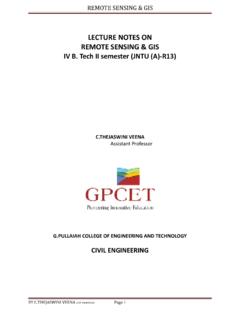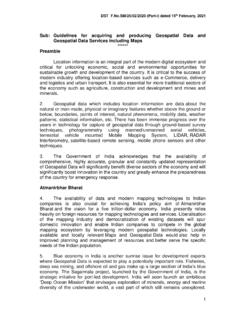Transcription of INTRODUCTION TO ENGINEERING SURVEYING (CE 1305)
1 INTRODUCTION TO ENGINEERING SURVEYING (CE 1305) SrDr. Tan LiatChoonEmail: 016-4975551 SURVEYING Information In Civil ENGINEERING Projects1 INTRODUCTION to SurveyingDefinition: SURVEYING may be defined as the art of making measurements of the relative positions of natural and man-made features on the earth s surface, and the plotting of these measurements to some suitable scale to form a map, plan or section(S. Raymond, 1979)2 INTRODUCTION to SurveyingDefinition: SURVEYING is the art of making relatively large precise measurements with a maximum of accuracy and with a minimum expenditure of time and labour(Philip Kissam, C.)
2 E., 1956)3 INTRODUCTION to SurveyingWhat is SURVEYING ? SURVEYING or land SURVEYING deals with determination of relative location of point on or near the surface of the earth. It is concern with measurement of distance on land and area of object It involves measuring horizontal or vertical distribution between terrestrial object, measuring craggy between terrestrials lines, determining direction of lines, establish point by determine angular and linear measurement It involve measurement a relative position of points on earth surface, whether natural and artificial4 INTRODUCTION to SurveyingWhat is SURVEYING ?
3 It is the technique, profession and science of accurately determining the terrestrial or 3D position of points and the distances and angles between them. These points are usually on the surface of the earth and they are often used to establish landmaps and boundaries forownership or governmental purposes It is the art of making suitable measurements in horizontal or vertical planes. This is one of the important subjects of civil ENGINEERING . Without taking a survey of the plot where the construction is to be carried out, the work cannot begin It is the art of determining the relative positions of different object on the surface of the earth by measuring the horizontal distance between them and by preparing a map to any suitable scale.
4 Thus, in this process, the measurements are taken only in the horizontal plane5 INTRODUCTION to SurveyingThe purpose of SURVEYING :Is to locate the positions of points on or near the surface of the earth. Some surveys involve the measurement of distances and angles for the following reason: (1)To determine horizontal positions of arbitrary points on the earth s surface(2)To determine elevations of arbitrary points above or below a reference surface, such as mean sea level(3)To determine the configuration of the ground(4)To determine the directions of lines(5)To determine the lengths of lines(6)To determine the positions of boundary lines(7)To determine the areas of tracts bounded by given linesSuch measurements are data-gathering measurement6 INTRODUCTION to SurveyingThe purpose of SURVEYING .
5 In other surveys, it is required to lay off distances and angles to locate construction lines for buildings, bridges, highways, and other ENGINEERING works, and to establish the positions of boundary lines on the ground. These distances and angles constitute layout measurements(Francis H. Moffitt, 1982)7 History of Surveying1)Egyptian: SURVEYING had it s beginning in Egypt about 1400 BC Land along the Nile River was divided for taxation. Plots were swept away by annual floods of Nile River The ROPE-STRETCHERS Egyptian surveyors were called to relocate the land boundaries with ropes having markers at unit distances Extensive use of SURVEYING in building of Egyptian monuments2)Greeks: Expanded Egyptian work and developed science of geometry Developed one of the earliest SURVEYING instruments Diopter(a form of level)8 History of Surveying3)Romans.
6 Developed SURVEYING into a science to create the Roman roads, aqueducts, and land division systems Surveyors held great power, had schools and a professional organization Developed several instruments: Groma cross instrument used to determine lines and right angles Libella A frame with a plumb bob used for leveling Chorobates 20 straight edge with oil in notch for leveling4)13thCentury: The Arabs kept Greek and Roman science alive and the Italian wrote the instructions o SURVEYING , called Practical geometry Quadrans square brass frame capable of turning angles up to 90 and has a graduated scale developed by an Italian named Von Piso9 History of Surveying5)18th& 19thCenturies: The need for maps and locations of national boundaries caused extensive SURVEYING , especially by the English 1785.
7 United Stated began extensive surveys of public lands into one mile square sections 30 states surveyed under the Public Land System (also called the Rectangular System) 1807: United States Geological Survey founded to establish an accurate control network and mapping Famous American Surveyors: George Washington, Thomas Jefferson, George Rogers Clark, Abe Lincoln and many more10 History of Surveying6)20thCentury and Beyond: As technology advanced, population increased, and land value caused development of licensure for surveyors in all states Educational requirements for licensure began in the early 1990 s Capable of electronic distance measurement, positioning using Global Positioning System (GPS), construction machine control, and lidar(scanning) mapping Involvement in rebuilding of the infrastructure and Geographic Information System (GIS)
8 Shortage of licensed professionals is projected well into the 21stcentury 11 Today Land SurveyingToday land SURVEYING affects most everything in our daily lives. A few of the areas where SURVEYING is being used are as follow: To map the earth above and below the sea To prepare navigation maps (digital or hardcopy) To establish boundaries of public and private lands To develop database for natural resource management and sustainable development To develop ENGINEERING data for: Bridge construction Roads Buildings Land development12 Land Surveyor1)The job of the land surveyors is to find and mark certain locations on land2)Over time, development, vandalism and acts of natural often wreak widespread destruction on documentation, so the land surveyor is often forced to consider other evidence such as fence locations, monuments on neighboring property, recollections and relocation of the features13 Land Surveyor3)
9 The work of the land surveyor is very varied and his practice may fall under one or more of various categories, such as cadastral SURVEYING or SURVEYING for title, ENGINEERING SURVEYING , topographical SURVEYING , photogrammetry , geodetic SURVEYING and hydrographic SURVEYING . Except for geodetic SURVEYING and photogrammetry , the other categories in land SURVEYING involve essentially large-scale Work of the Land Surveyor1)Research, analysis and decision making Selecting techniques, equipment and final point locations2)Fieldwork & Data Acquisition Making measurements and recording data in the field3)Computing & Data Processing Preparing calculations based upon the recorded data to determine locations, areas, volumes, )Mapping or Data Representation Plotting data to produce a map, plan, or chart in the proper form5)
10 Setting Locating and establishing monuments or structure in the proper locations in the field15 Importance of Land SurveyingSurveying can be carried out to achieve all or any of the following purpose: For the determination of the earth size and shape For setting out construction works and roads For navigational purposes The making plans, chart and maps For collection of tracts and details For location of features 16 Purpose of SURVEYING in the Field of Civil EngineeringSurveying can be carried out to achieve all or any of the following purpose.






